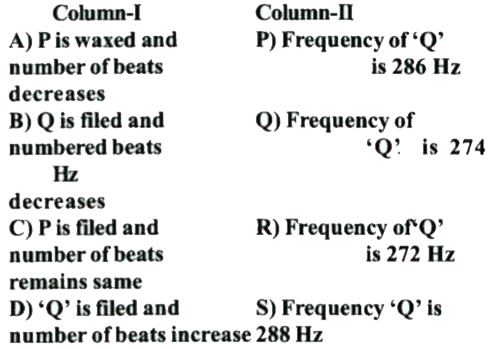Tuning fork F1 has a frequency of 256 Hz and it is observed to produce 6beats/second with another tuning fork F2. When F2 is loaded with wax, it still produces 6beats/sec with F1. The frequency of F2 before loading was
253Hz
262Hz
250Hz
259Hz
The correct Answer is:B
To solve the problem, we need to find the frequency of tuning fork F2 before it was loaded with wax. We know the following:
- Frequency of tuning fork F1 (NA) = 256 Hz
- Number of beats produced = 6 beats/second
- When F2 is loaded with wax, it still produces 6 beats/second with F1.
1. Understanding Beats:
The number of beats per second is given by the absolute difference in frequencies of the two tuning forks. Therefore, we can write:
|NA−NB|=6
where NB is the frequency of tuning fork F2.
2. Setting Up the Equation:
Since NA=256 Hz, we can set up two possible equations based on the beat frequency:
NA−NB=6(1)
or
NB−NA=6(2)
3. Solving Equation (1):
From equation (1):
256−NB=6
Rearranging gives:
NB=256−6=250 Hz
4. Solving Equation (2):
From equation (2):
NB−256=6
Rearranging gives:
NB=256+6=262 Hz
5. Analyzing the Effect of Wax:
When F2 is loaded with wax, its frequency decreases. Therefore, if NB was initially 262 Hz, after loading with wax, it would produce a lower frequency, which would still result in 6 beats with F1 (256 Hz). This means that the only feasible solution for NB before loading with wax is:
NB=262 Hz
Final Answer:
The frequency of tuning fork F2 before loading with wax was 262 Hz.
- Number of beats produced = 6 beats/second
- When F2 is loaded with wax, it still produces 6 beats/second with F1.
The number of beats per second is given by the absolute difference in frequencies of the two tuning forks. Therefore, we can write:
|NA−NB|=6
where NB is the frequency of tuning fork F2.
Since NA=256 Hz, we can set up two possible equations based on the beat frequency:
NA−NB=6(1)
or
NB−NA=6(2)
From equation (1):
256−NB=6
Rearranging gives:
NB=256−6=250 Hz
From equation (2):
NB−256=6
Rearranging gives:
NB=256+6=262 Hz
When F2 is loaded with wax, its frequency decreases. Therefore, if NB was initially 262 Hz, after loading with wax, it would produce a lower frequency, which would still result in 6 beats with F1 (256 Hz). This means that the only feasible solution for NB before loading with wax is:
NB=262 Hz
The frequency of tuning fork F2 before loading with wax was 262 Hz.
Topper's Solved these Questions
- WAVES AND ACOUSTICSBOOK - A2ZCHAPTER - WAVES AND ACOUSTICSEXERCISE - Stationary Waves
20 Videos
- WAVES AND ACOUSTICSBOOK - A2ZCHAPTER - WAVES AND ACOUSTICSEXERCISE - Vibration Of String
24 Videos
- WAVES AND ACOUSTICSBOOK - A2ZCHAPTER - WAVES AND ACOUSTICSEXERCISE - Superposition And Interference
23 Videos
- VECTORSBOOK - A2ZCHAPTER - VECTORSEXERCISE - Chapter Test
29 Videos
- WORK, ENERGY, POWER AND COLLISIONBOOK - A2ZCHAPTER - WORK, ENERGY, POWER AND COLLISIONEXERCISE - Chapter Test
29 Videos
Similar Questions
The frequency of tuning fork 'A' is 250Hz. It produces 6 beats/sec, when sounded together with another tunning fork B. If its arms are loaded with wax then it produces 4 beats/sec. Find the frequency of tuning fork B.
View SolutionA tuning forks when sounded together produce 3 beats per second, when sounded with another tuning fork B. when prongs of B are loaded with 1 g of wax, the number of beats become 3 per second. What is the frequency of B ?
View Solution
Knowledge Check
Turning fork A of frequency 305 Hz produces 5 beats s−1 with another turing fork B. After filling tuning fork B, it produces 3 beats s−1 with A. The frequency of B before filling was
A300 HzB313 HzC310 HzD308 HzTuning fork A of frequency 205 Hz produces 5 beats/sec with another fork B. After filing the tuning fork B, it produces 3 beats/sec with A. What was the frequency of the fork B before filling?
A310 HzB313 HzC308 HzD300 HzA tuning fork A produces 4 beats/sec with another tuning fork B of frequency 320 Hz . On filing the fork A , 4 beats/sec are again heard. The frequency of fork A , after filing is
A324 HzB320 HzC316 HzD314 Hz
A tuning fork A, marked 512 Hz, produces 5 beats per second, when sounded with another unmarked tuning fork B. If B is loaded with wax, the number of beats is again 5 per second. What is the frequency of tuning fork B when not loaded?
View SolutionA tuning fork of frequency of 512Hz when sounded with unknown tunning fork produces 5 beats/sec. If arms of the unknown fork are filed then it produces only 3 beats/sec. Find the frequency of unknown tunning fork.
View SolutionFrequency of tuning fork A is 256 Hz. It produces 4 beats/second with tuning fork B. When wax is applied at tuning fork B then 6 beats/second are heard. Frequency of B is :-
View SolutionA tuning fork 'P' of frequency 280Hz produces 6 beats/s with unknown tuning fork 'Q'

View SolutionTwo tuning forks A and B are sounded together and it results in beats with frequency of 4 beats per second . When A is loaded with wax, they again produces 4 beats per second . If frequency of A is 256 Hz, then the frequency of B is
View Solution
